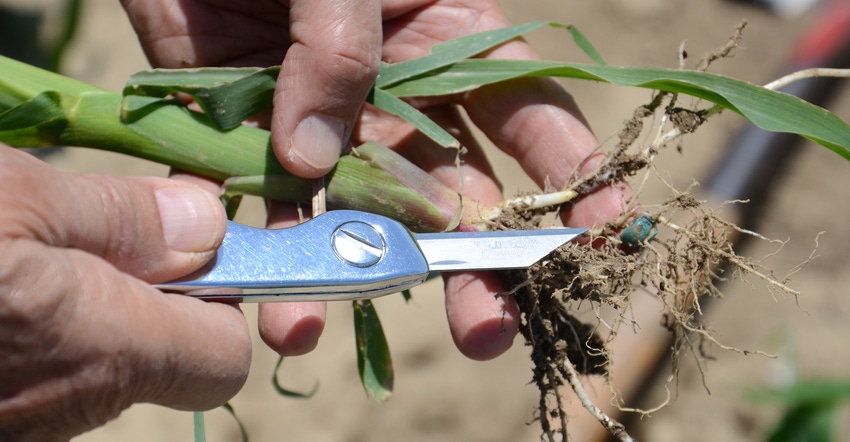
A pocketknife can be a useful tool when you’re scouting, especially in relatively young corn. If the ground is mellow enough and plants are small, you can use it to dig them up and check two things: planting depth and root health.
“It’s a good check on planting depth in corn after the fact,” Dave Nanda says. With corn, a grass plant, the seed carcass remains intact at the point it was placed in the ground, even after the seedling emerges, he explains. With legumes like soybeans, the seed splits into two halves and becomes the cotyledons that emerge above ground. But that’s not the case with a monocot like corn.
Nanda is director of plant genetics for Seed Genetics-Direct, Jeffersonville, Ohio. Seed Genetics-Direct is the sponsor of Corn Watch ’19. Follow the series weekly online and monthly in print to get an idea of what could be happening in your cornfields based on what’s happening in one field Nanda watches all year long.
Seed depth
If you set your planter to plant 2 inches deep but it planted at 2.5 inches instead, you will find the seed 2.5 inches below the surface, right where it was placed, Nanda says. On the other hand, if it was only placed 1.5 inches deep, that’s where you will find it. The coleoptile emerges and peeks through the ground’s surface, while the first roots move downward, leaving the seed in place.
If you’re troubleshooting a poor stand, knowing exact seeding depth may help eliminate possible causes, Nanda says. If you find a plant here and there that emerged after its neighbors, you can dig and check seed depth to see if it was placed shallower or deeper than the intended depth. Uniform depth placement in every row is critical to producing uniform emergence, Nanda says.
Sometimes emergence may not be uniform because the deeper you place a seed, the cooler the soil. With delayed planting this year, it could be more of a function of where moisture was, and whether soils near the surface dried out before germination and emergence occurred.
Root health
When examining root growth, even on younger plants, you want to see healthy-looking roots with some root hairs already developing, Nanda says. Brownish discoloration on seedling roots may indicate several things — none of which are good. A seedling disease may be affecting root growth. Or perhaps roots contacted either a band of anhydrous ammonia, if nitrogen was applied close to planting, or a starter fertilizer band with a high salt content.
Plants that are shorter than their neighbors or showing signs of wilting are good candidates for root checks, Nanda says. The aboveground symptoms could be related to what’s going on below ground, he notes. If roots are injured either by disease or contact with ammonia or a starter fertilizer band with excess salt content, they may not be able to function and take up enough nutrients and water to meet the needs of the young seedling.
Nanda often likes to dig both a poor-performing plant and a healthy plant and compare root systems. Often both the root mass and condition of the roots explain differences seen above ground, he says.
About the Author(s)
You May Also Like




